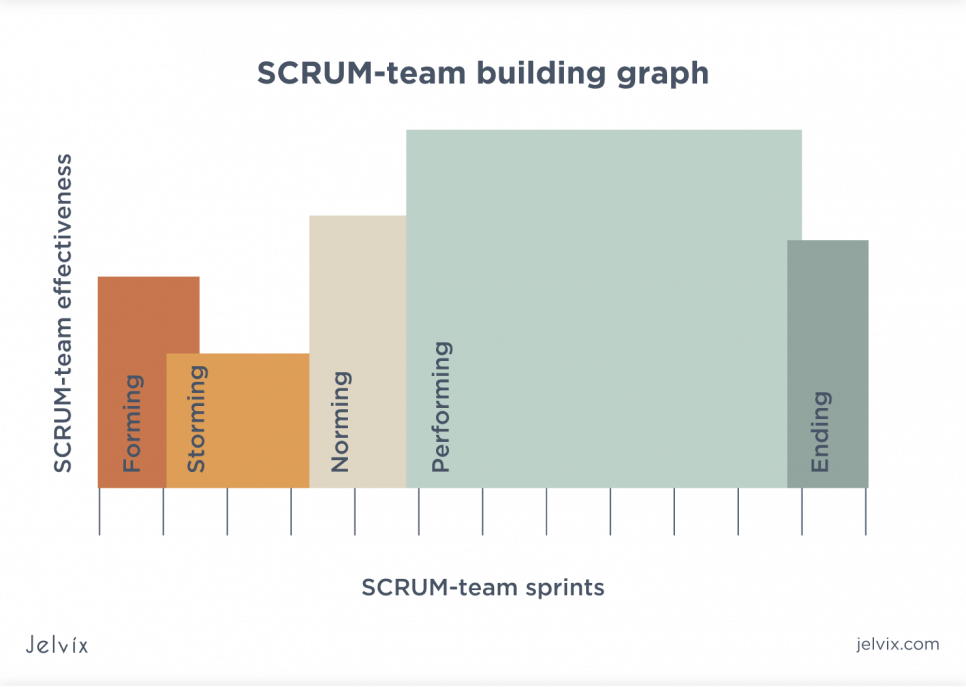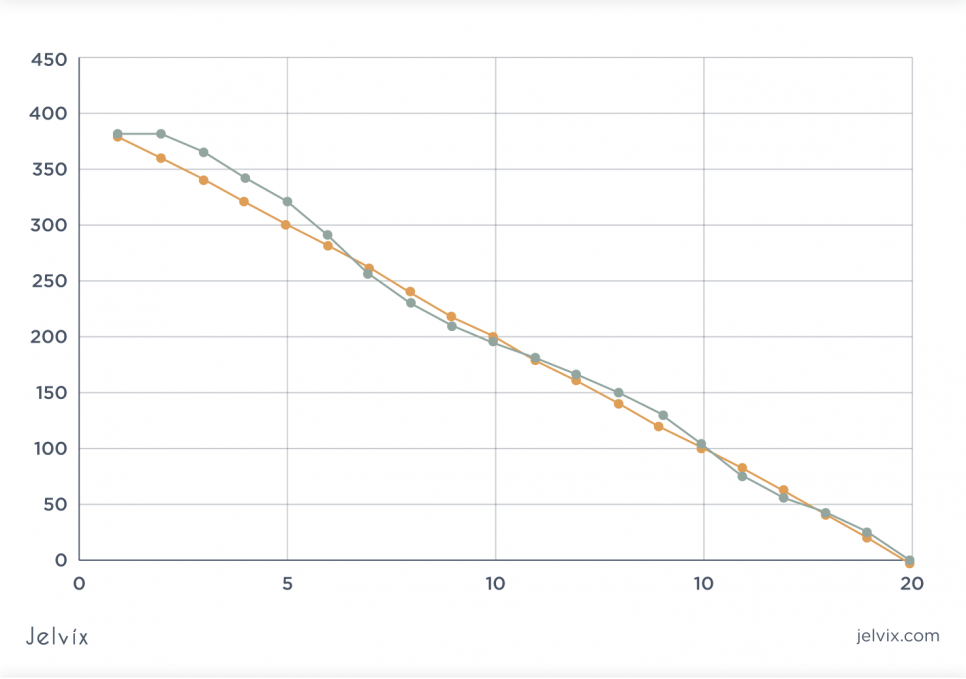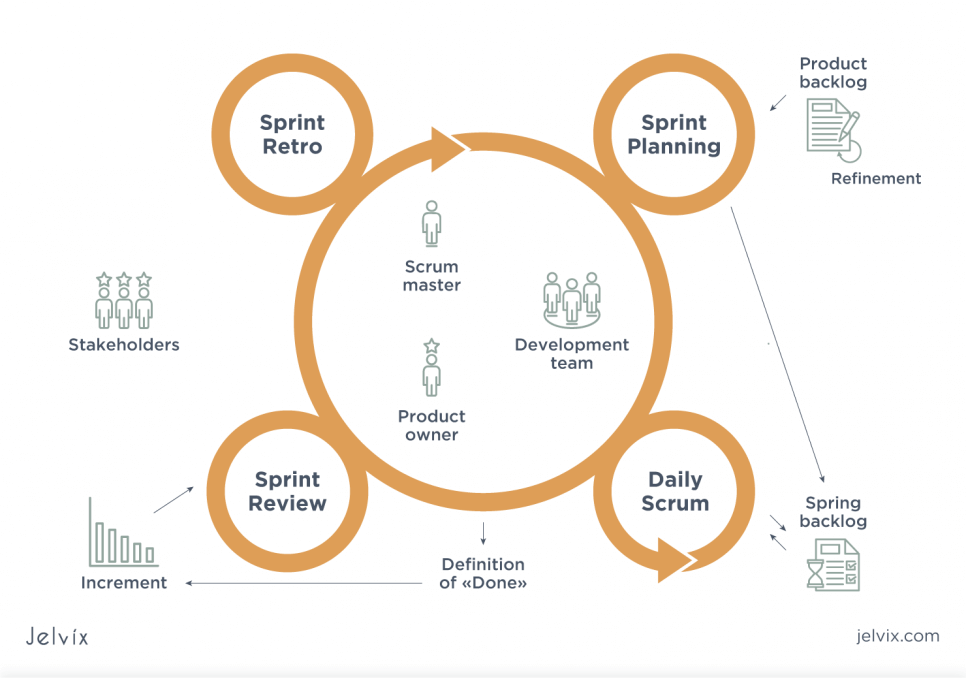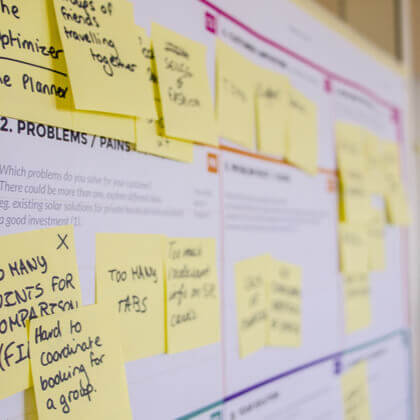A recent McKinsey study found that companies with Agile practices built into their operating models were faster coping with the COVID-19 crisis. By speeding up decision-making and redefining their priorities, IT companies could adapt to new industry landscapes and successfully organize their work in remote conditions.
The State of Agile report witnessed the growth of Agile adoption in both IT teams and other groups, as well as the desire of most IT professionals and developers to continue working in a distributed format. And in this, Scrum helped them — one of the most popular approaches to organizing work.
66% of IT teams use its structure, and others have chosen Scrum derivatives for themselves. Why is Scrum so remarkable? What is the best Scrum tool? Is Scrum free to use? Look for answers in our article.
Agile Definition
Before moving on to Scrum’s rules and values, let’s understand the definition of Agile. Agile refers to a methodology of self-organized teamwork that results in working solutions.
An Agile process is based on iteration and evolution, which means a constant stream of feedback and a focus on priorities. And advanced development approaches designed to deliver quality software quickly and aligning development with organizational goals and customer needs complement the agile process.
And Scrum is a scalable Agile technology in the software development process that permits teams to focus on delivering value in no time.
Learn the difference between Waterfall and Agile project management approaches.
What is Scrum, and Why is it Needed?
Scrum is a widely used process framework for project management that involves teamwork, accountability, and iterative progress towards a well-defined goal. According to Scrum, the product is developed by small, ready-to-release parts, each carried out as a short iteration or a “sprint,” which usually takes 1-2 weeks (up to 1 month).
Scrum teams strive to create production-ready and well-tested products with every iteration. A project ends when the product owner receives the required functionality or when further work is not required or economically justified.
The Scrum approach increases productivity and cuts time to value compared to traditional waterfall processes. Scrum processes allow organizations to adapt to transforming requirements and produce a product that fully meets business goals.
Scrum comprises roles, events, and artifacts (information carriers about the product). Each element of Scrum is interconnected with others and must be used.
Scrum team
This is the working group’s name, including the development team, the Scrum Master, and the Product Owner. There are no subgroups or hierarchies on a Scrum team — it’s a close-knit group of motivated professionals focused on one goal — the product.
Scrum roles
There are three crucial roles in classic Scrum:
A Product Owner is a link between the development team and the customer, whose task is to maximize the value of the developed product and the team’s work. One of the product owner’s primary tools is the Product Backlog Journal, which lists tasks sorted by priority.
A Scrum Master is the service leader. Its task is to train and motivate the team to maximize its effectiveness by consistently removing obstacles.
A Development Team is a group of specialists working on a product and independently transforming the backlog into a working solution.
The recommended team size is seven employees. According to the creators of Scrum, larger teams spend more resources on communication, while smaller groups may not have all the skills and do less work per unit of time.
Scrum events
Prescribed events define regularity and minimize meetings not defined in Scrum. They limit all events in time. Once a sprint starts, its duration is fixed and cannot be extended or shortened. The rest of the events can end if they achieve the goal of the event.
There are five types of scrum events:
- Sprint Planning is conducted by all Scrum team members presenting the product, and everyone can speak out about what interests or worries him. During the meeting, priorities are set, and deadlines are estimated.
- Daily Scrum is an everyday process during sprints. Daily Scrum is an everyday process during sprints. It is short (up to 15 minutes) and should help you plan your development team’s daily schedule. This process helps to clarify operational difficulties and plan upcoming sprint work. The developers are usually present in full force.
- Sprint Review is usually done at the end of a sprint, where the team shows the working product developed during the sprint.
- Sprint Retrospective refers to a discussion of how the team coped with the sprint tasks and an outline of how they can improve the quality of work in the future.
- In addition, during the sprint, a Backlog Refinement is held, where the backlog elements are discussed and prepared for the next sprint. As part of this meeting, the product owner and the development team review the prioritization of items or division backlog items into smaller components.
Scrum artifacts
The artifacts defined in Scrum provide maximum transparency of essential information so that it entirely focuses all team members on the task at hand. They are used to help determine the workload that is currently in and out of the team. So, what are the 5 Scrum artifacts?
The Product Backlog, or a set of user stories, represents the functionality required/desired by the product team. Usually, this list is formed by the product owner and can be included in the current sprint. There are two essential points about the relationship between the sprint backlog and including items in the sprint.
First, the team decides what to add to the sprint and takes responsibility for delivering those things. Second, before an item is added from the backlog to a sprint, the team must ensure that the backlog has all the information this item needs. This is a checklist of things that must be submitted before appending an item.
An Increment is a real stepping stone towards achieving the product’s goal. Each increment is added to all previous increments and is carefully checked to ensure that they work together. At the end of the sprint, the new increment should be “Done,” which means it is working and meets the scrum team’s “readiness” criteria.
The Burn-down chart can be upward or downward depending on what the team faces while completing the task. This is not a report on the team’s progress but a method of overcoming difficulties and staying active.
The product release / burn-down product chart is updated by the scrum master at the end of each sprint. The horizontal axis corresponds to sprints; the vertical axis displays how much work is left from the beginning of each sprint to the end of the project.
What is a Scrum Board?
Scrum boards are used by all teams that plan their work in sprints — time-limited periods to create a ready-made increment of work. It is a visual snapshot of the work that is being done as a team. Don’t confuse it with Kanban boards, which track workflow.
Scrum boards can be broken down into four types:
- Stories: they present a sprint backlog (a list of activities and experiments to be conducted, managed by the team’s product owner). These backlog items are written in the style of “As a <user role>, I want <action> to <profit>.”
- What to do: Subtasks that haven’t been to work yet. They are displayed as cards or stickers and contain essential information about the owner and due dates.
- In Progress: Subtasks being worked on.
- Done: Completed subtasks that can be removed from the board at the end of the sprint.
Scrum framework rules
While roles, events, and artifacts are considered the basic rules of Scrum, other principles and practices also add efficiency to the process.
- All sprints must be of the same length.
- The next sprint begins instantly after the completion of the previous one.
- Any sprint starts with planning, for which the employees team organizes a daily scrum every morning.
- Each sprint must be reviewed so that the stakeholders can provide feedback.
- Complementing a sprint backlog during a sprint is not recommended.
Benefits of Using Scrum Frameworks
- Reduced development costs. Agile Scrum software has long been proven effective. The roles of developers are more diverse, so the team can effectively test our products. This reduces the need for specialization, which ultimately reduces costs.
- Shortened time to market while improving product quality. With the best Scrum tools, the end consumers get a product 30-40% faster.
- Timely feedback on customer needs. Waterfall organizations introduce essential features and functionality twice a year, and it is not uncommon for them to lose customers. And those that remain may still be unhappy with such a low efficiency of the supplier. In contrast, working in short, frequent cycles delivers products almost on demand and helps you quickly adapt to change.
- The joy from work and high team spirit. Every development team knows how much a release inspires. With Scrum, they celebrate release not two, but at least 12 times a year.
- Higher income. Customer funds are received more than twice a year, and the processing overhead is kept to a minimum. Regular feedback is also a factor in increasing your ROI — making corrections in the process is cheaper than correcting something after the project is completed.
What is the Best Scrum Tool?
Over 50 frameworks have been created for Agile development, which adapts and hybridizes so that each team can find its way to become more Agile.
Is Agile software free? We will list some tools based on Scrum and Agile approaches that implement specific techniques (backlog management, burnout diagram) and are freely available (no commercial / paid version!).
Scrumpy
Scrumpy helps manage iterations and releases and provides a long-term overview of products so teams can better serve customers and save time by finding answers to common questions.
Key features
- Requirements Management
- Prioritization
- Task Management
- Supports Scrum
- Portfolio Management
Trello
While Trello looks simple at first glance, its cards have everything you need to manage projects. You can move each card between lists to mark progress, comment for immediate feedback, and download files from your desktop, OneDrive, Google Drive, and more.
Key features
- Business Process Automation
- Activity Dashboard
- Backlog Management
- Campaign Management
- Alerts / Notifications
- Assignment Management
- Budget Management
- Brainstorming
- Billing & Invoicing
- Client Management
iceScrum
The platform offers a module that permits administrators to distribute roles between teams. For one team with a limitless number of employees, iceScrum is free, but it limits the number of public projects in the free version to one.
Key features
- Tracking Errors
- View Gantt Chart / Timeline
- Problem Management
- Iteration Control
- Kanban Board
- Portfolio Management
- Prioritization
- Product Roadmap
- Tracking Progress
- KPI Monitoring
ScrumDesk
ScrumDesk is a flexible project management tool that supports all Scrum rituals for medium-sized and small teams. It’s completely transparent, user-friendly, and free for four users.
Key features
- Backlog Management
- Kanban Board
- Cost-to-Completion Tracking
- Dependency Tracking
- Gantt / Timeline View
- Idea Management
- Iteration Management
- Multi-board
- Prioritization
KanbanTool
It is an online tool with simple time tracking and detailed Kanban analytics and metrics. It contains Kanban cards, tags, colors, tracks, and due dates to help you ensure that your project progresses clearly and visually. The basic version is free for two users and two boards.
Key features
- Client Portal
- Project Planning
- Portfolio Management
- Dependency Tracking
- Kanban Board
- Idea Management
- Milestone Tracking
- Resource Management
- Prioritization
- Multi-board
VersionOne Lifecycle
This Scrum planning tool offers many valuable elements that are designed so that you can quickly scale and switch between teams, portfolios, project workspaces, and locations. For one team, Agile VersionOne Lifecycle will be free.
Key features
- Approval Workflow
- Collaboration Tools
- Continuous Delivery
- Budget Management
- Continuous Deployment
- Defect Tracking
- Drag & Drop
- Gantt / Timeline View
- Idea Management
- Iteration Management
Zepel
It is the simplest project management tool built for product teams. Zepel allows you to collect customer requests from multiple tools, turn them into priorities, and track development progress at each stage. This Scrum board software can divide complex features and create user stories, and set up sprints quickly.
Key features
- Burnout Plots and Cumulative Charts
- Sprint Tracking Widget From Desktop
- Team Management
- Deep Integration with GitHub or Bitbucket
- Status Tracking
- Developer-friendly APIs
- Backlog Management
- Workflow Management
- Kanban Board
- Retrospectives Management
Zoho Sprints
It is one of the most practicable online Scrum tools built to release products in iterative sprints. With Zoho, you can track your sprint progress and manage all work items, user stories, and bugs in one place.
Key features
- Audit Trail
- Automatic Time Capture
- Backlog Management
- Billing & Invoicing
- Brainstorming
- Billable and Non-billable Hours
- Contact Management
- Bug Tracking
- Create Subtasks
- Customizable Templates
Agilefant
Agilefant is a functional and straightforward Scrum-style software that makes project management and other related activities more convenient. It easily adapts to any team’s working style and scales from long-term planning and portfolio management to personal to-do lists.
Key features
- Dependency Tracking
- Project Planning
- Backlog Management
- Milestone Tracking
- Budgeting / Forecasting
- Prioritization
- Progress Tracking
- Daily Reports
- Reporting / Analytics
- Iteration Management
Jira
“Is Jira a Scrum tool?” you may ask. Indeed it is! Jira software de facto supports any Agile software development methodology and provides almost all the foreseeable capabilities that development teams need. It has custom filters, custom Scrum boards, and visual project reports. This software tool is perfect for large groups, but the free basic version only covers ten users a month.
Key features
- User Stories
- Scrum Boards Software
- Customizable Control Panel
- Progress Reports
- Backlog Management
- Bug and Problem Scrum Tracker
- Time Tracking
- Sprint Tools
- Real-time Reporting
- Third-party Integrations
These Agile Scrum tools described above are just a drop in a sea of other handy project tools that serve the same purpose — creating a more transparent workflow and facilitating cooperation within the development team.
Which Scrum Framework is Right for You?
It will be easier for you to choose the optimal agile methodology to consider all the viable options. The variety allows you to pick the one that best suits your team’s needs and working style.
In terms of free Scrum tools, small teams might consider Trello, for example. This is one of the best free options for those running a team of three people. Trello lets you manage teamwork, create multiple boards and tasks, add labels, attachments, descriptions, and more. This can satisfy the basic needs of a tiny group that is following the Agile methodology.
However, in some cases, pay attention to Scrum tools. For example, if the development team is growing, which makes the management process more difficult. Even if there are only six or seven people in the team, each working on various tasks, your Scrum project tool should include different workflows, release planning, thorough reporting (burnout charts, cumulative flowcharts, sprint reports), etc.
Well, if your team has more employees and you want to use large-scale Agile methodologies such as LeSS, or Scaled Agile Frameworks, you will need even more features, and no free tool will provide them. In this case, pay attention to Redmine, or Atlassian JIRA.
Conclusion
Agile software development principles are now the industry standard for many innovative projects. In the era of competition, it is critical to support a near-continuous business transformation.
The Jelvix team actively uses Agile methodology to flexibly and quickly deliver applications that meet our clients’ business requirements. If your project requires Agile software development or you want to improve an existing solution, please contact us. To learn more about our approach to software development, click here.
Need a qualified team?
Fill the expertise gap in your project and task management and get full control over the process with Jelvix team.

















